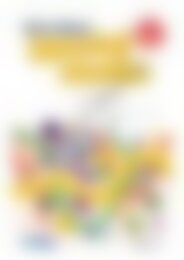PR-6171IRE Science A STEM Approach - 1st Class
You also want an ePaper? Increase the reach of your titles
YUMPU automatically turns print PDFs into web optimized ePapers that Google loves.
Lesson 2<br />
Materials<br />
IT’S A STRETCH<br />
Lesson Plan<br />
Introduction:<br />
1. Display page 103 on the whiteboard. Ask pupils to describe what each action is and what the<br />
action is called. Write the name of the action underneath the pictures; i.e. twist, stretch, bend and<br />
squash. This can be printed out and displayed in the classroom on a word wall so pupils can refer<br />
to it in later lessons. Ask pupils to suggest examples of times they have used one of these actions.<br />
Development:<br />
2. Pupils familiarise themselves with playdough by playing a game of Shape It! using playdough and<br />
the spinner from page 104. Divide the class into small groups and give each pupil in the group<br />
three small balls of playdough each. The aim of the game is to create a picture using playdough<br />
that has been changed by twisting, bending, squashing or stretching.<br />
Explain the game instructions as follows:<br />
• One person from your team spins the spinner and then shapes one piece of their dough using<br />
the action they landed on. Another member of the team is responsible for timing ten seconds.<br />
• Each person will have ten seconds. Listen for the timer or bell.<br />
• Pass the spinner to the next pupil and repeat the steps until all pieces of playdough have had<br />
their shape changed. Another member of the team is responsible for timing ten seconds.<br />
• When all pupils have changed their three pieces of playdough, pupils work together to create a<br />
picture with the changed shapes. Pupils will have three minutes to make a picture/image. At the<br />
end of the activity, each group should take a digital photograph of their picture/image.<br />
3. Pupils can conduct a quick gallery walk to view other groups’ pictures.<br />
4. Divide the playdough so each person receives a piece for individual experimentation. Pupils also<br />
receive one rubber band each. Pupils use the checklist on page 105 to complete the experiment<br />
and record their observations.<br />
Differentiation<br />
• Some pupils will need additional support in understanding the task and recording the results -<br />
support to be provided to ensure that all pupils are able to complete the experiment.<br />
Reflection:<br />
5. Using a class whiteboard or large sheet of paper, as a class construct a Venn diagram about their<br />
observations in order to highlight the differences and similarities between how playdough and a<br />
rubber band change shape. Reinforce that the rubber band is an object that can change shape<br />
but it returns back to its original shape, while the playdough can change shape and stays in its new<br />
shape. Pupils can write something along these lines in their conclusion if they haven’t already done<br />
so. The Venn diagram can be added to the word wall area to begin to create a working wall.<br />
Viewing sample<br />
Consolidation:<br />
Distribute photographs of the Shape It! activity and challenge pupils to label the different ways in<br />
which the playdough has been changed - encourage pupils to use the scientific vocabulary from the<br />
word wall.<br />
102 <strong>Science</strong>:<br />
A <strong>STEM</strong> AP<strong>PR</strong>OACH<br />
<strong>1st</strong><br />
CLASS<br />
978-1-912760-15-2 Prim-Ed Publishing – www.prim-ed.com

















